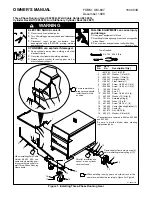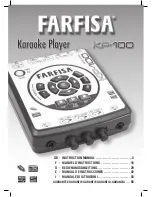
Maintenance
Clean the outside case by occasionally
wiping with a clean damp cloth. Do not
use any cleaning agents, bleaches,
detergents or polishes, including those
in aerosol cans. Avoid spraying air
fresheners, hair spray, paint or other
aerosols near the CO Alarm. Do not
place air fresheners near the unit. Use
the narrow nozzle of a vacuum cleaner to
remove fluff and other contamination
from the cover slots and gas entry holes.
Caution: Do not paint the CO Alarm.
Remove the CO Alarm when decorating.
Do not allow water or dust to contaminate
the Alarm.
Warning:
Do not open or tamper with the
CO Alarm. There are no user serviceable
parts inside and this can damage the
Alarm.
Battery Replacement
Check the ‘Replace by’ label on the side
wall - if it has been exceeded replace
the entire unit. If the Replace by label
on the side wall has not been exceeded,
remove the Alarm from the mounting
plate, remove the battery cover (see
figure 7) and replace the batteries. Use
only
Duracell Alkaline MN2400BK AAA
size batteries (obtainable from local
retailers). Insert the new batteries with the
orientation shown on the base. Replace
the battery cover and replace the Alarm
back on its mounting plate (this action
automatically switches on the batteries).
Button test the Alarm (after 15 seconds) to
check the batteries are installed correctly
and that they are not depleted.
Warning!
Constant exposures to high or low
temperatures or high humidity may reduce
battery life. Use only batteries specified
in marking. Use of a different battery
may have a detrimental effect on alarm
operation. For environmentally sound
disposal, remove the Alarm from its
mounting plate
Quick Test with Carbon Monoxide
The Carbon Monoxide Alarm checks
for CO gas every 4 seconds and when
exposed to the CO gas, the red light will
flash (as per Table B) to confirm that it
is detecting the CO gas. The Alarm can
be tested with carbon monoxide gas by
using one of the kits that comes with the
gas either in a glass phial or aerosol can.
Follow the instructions on the kit.
If a test gas kit is not readily available, it is
also possible to gas test the Alarm using
a joss stick or cigarette smoke. To do this,
remove the Alarm from its base and slide
the power switch to the ON position (see
fig 8). Fill a suitable size plastic bag with
smoke from the joss stick or cigarette.
Insert the Alarm into the smoke filled bag
and seal it closed. Within seconds, the red
light will begin to flash (as per Table B) to
confirm that the Alarm has detected the
CO gas in the bag. To check the Alarm
sound, momentarily press the test button
and within seconds the horn will sound
briefly. Slide the power switch to the OFF
position and replace the Alarm on its
mounting plate.
6. What to do when the alar
6. What to Do When the
Alarm Sounds
Warning!
Actuation of your CO Alarm
indicates the presence of carbon
monoxide (CO) which can KILL YOU. If
an alarm signal sounds:
8
Figure 7
OFF
Position
ON
Position
Figure 8






























